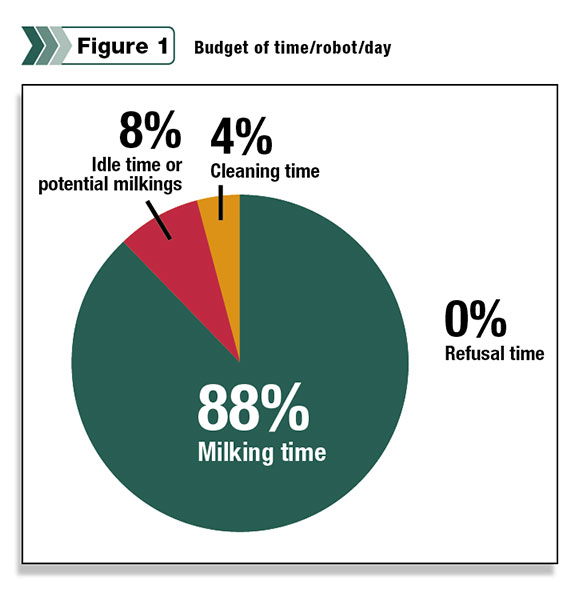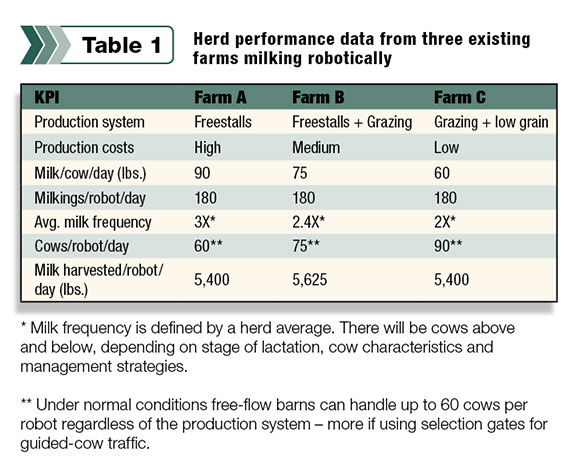“If you can’t measure it, you can’t manage it.” This is a very popular, well-known quote and the root of its meaning is critical to a robotic milking operation.
Like other industries, it’s absolutely essential that all dairy farms have a strategic plan in place. But to gauge how well an automated milking operation is running,
I recommend using some specific key performance indicators (KPIs).
KPIs can be used to help you achieve your goals by setting targets for the short term, mid term and long term. They need to be realistic considering the unique circumstances of your dairy.
Robotic milking KPIs should be established at three management levels: the herd, sub-systems and the milking procedure.
The herd
Standard KPIs like days in milk, pregnancy rate, days open, somatic cell count, etc., are very well defined and familiar to our industry. They should be used in addition to the following:
- Robot capacity – The capacity of a single-box robotic milking station is determined by milk frequency (x) number of cows to be milked. Generally, the higher number of cows, the lower the milk frequency and vice versa. This is just a matter of strategy and efficiency. For example, a producer can decide if he or she wants to milk 60 cows 3X or 90 cows 2X. At the end of the day, the producer can achieve 180 milkings to spend according to his or her own operational circumstances and goals.
- Volume of milk or butterfat harvested per robot per day – This is directly affected by two variables: number of cows to be milked per station per day and individual milk production per cow. Feeding strategies such as pTMR (TMR at the feedbunk plus concentrate at the VMS), grazing, organic milk production, freestalls, bedpacks and all possible combinations thereof, will also impact the outcome. For example:
Freestalls and pTMR: 60 cows per robot multiplied by 95 lbs per cow per day = 5,700 lbs per robot per day
Grazing, freestalls and pTMR: 80 cows per robot multiplied by 70 lbs per cow per day = 5,600 lbs per robot per day
When dairies harvest below 4,000 lbs per robot per day under open market conditions – like in the U.S. – it is necessary to evaluate and adjust; however, countries under the quota system may have to limit their performance per milk station due to growth restrictions, which is, of course, unrelated to dairy management practices.
Sub-systems
Generally, most sub-systems follow standard industry principles. Major areas of difference are:
- Nutrition – What should be measured here is the percentage of concentrate consumed per cow per day (at the robot or external feed stations). Feed consumption can fluctuate 80 to 100 percent. If lower, cow health can be compromised or system configuration should be checked; if higher, it would suggest cows are achieving the nutritional component but missing the motivational side. Just like a salesperson working on commission, cows need to be motivated to visit the milking station and work hard every day – keeping the balance between feeding value, motivation and rumen health.
- Milk quality – Somatic cell and bacteria counts are a must in all programs. MDI (mastitis detection index) is an excellent tool to manage daily routines. Your herd’s MDI = milking interval (x) conductivity (x) blood. Target MDI is less than 1.2. If higher than 1.4, check the following:
Milking interval: Less than 12 hours for all lactating cows
Conductivity: Below 7 (mS/cm)
Blood: 0
If one or more is elevated, take action according to your standard operating procedures.

The milking procedure
From an operational standpoint, the main difference between robots and conventional milking parlors is, of course, the milking procedure. Robotic milking is all about time – and idle seconds are a main source of opportunity to harvest more milk per station per day.
To evaluate milking efficiency, we have to look at the robot’s activity in a 24-hour period:
- Milking time – The amount of time the robot is only milking cows. It allows us to evaluate cow traffic to the station and how feeding strategies, cow comfort and cow training protocols are influencing cow motivation. A good target is at least 20 to 21 hours spent milking.
- Cleaning time – Depending on the manufacturer, this is typically between one to 1.5 hours daily to keep the robot clean.
- Idle time – This is the time the robot is empty and/or waiting for another cow to visit. These two to three hours should be considered as potential milking time.
- Refusals – The robot will refuse a cow if she does not have milking permissions. The goal should be zero refusals, which can easily be achieved by adding a pre-selection gate.
To evaluate the robot’s performance, we have to look at:
-

Stall time: This is defined as from when a cow enters the station to when she exits – including time spent prepping, milking and post-spraying. A good goal is less than seven minutes per milking.
The relationship between stall time and milking time is defined as:
- Total milkings available per robot per day: A good target is 180 available milkings. This is how it works:
One day: 24 hours or 1,440 minutes
Milking time: 21 hours or 1,260 minutes
Average stall time: 7 min
Total milkings available per robot: 1,260 min divided by 7 min per milking = 180 milkings per robot
per day
Other options to evaluate milking efficiency are:
- Production per milking: Over 30 lbs
- Milk flow rate = Production per milking (÷) stall time. Above 4 lbs per minute is ideal but, in general, over 3.5 lbs per minute is considered acceptable.
Robotic milking is a highly interactive system and capacity will be defined by maximizing the number of milkings per station per day.
Optimizing your robotic milking system requires numerous considerations which must be aligned with your facility, management philosophies and, of course, your cows. But when aiming for improvement, you have to consistently measure your performance. It’s the only way to reach your goals and know you’re doing better. PD
Rodriguez is a veterinarian and works for DeLaval as an adviser for automated milking systems in North America.Email Francisco Rodriguez.





